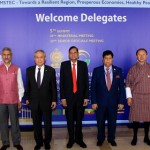The unique regional grouping linking five countries of South Asia (India, Bangladesh, Nepal, Bhutan and Sri Lanka) and two countries of Southeast Asia (Thailand and Myanmar) holds its long-awaited fifth summit in Colombo March 30. On it rides a hefty burden of expectations to advance regional cooperation. Meticulous preparations behind the scenes have created an atmosphere of hope for its success.
Building ambition
BIMSTEC(Bay of Bengal Multi-Sectoral Technical and Economic Cooperation) completes 25 years of the journey that began in Bangkok in June 1997. Until 2014, it was a low-profile, unassuming sub-regional grouping that had much to be modest about. But as hopes of Saarc cooperation faded, India took a bold initiative that helped the smaller grouping to develop ambition. The leaders of BIMSTEC were invited to a historic retreat for deep reflection; they also interacted with the Brics leaders. This was in Goa in October 2016. Two years later, BIMSTEC felt adequately confident to project itself as a dynamic regional grouping, ready to work for “a peaceful, prosperous and sustainable Bay of Bengal Region”. It should. It represents 1.7 billion people and a combined GDP of $3.8 trillion, which can accelerate economic development through greater integration.
All foreign ministers, except of Myanmar, will be present in Colombo. But all heads of state or government will attend the summit virtually from their capitals-a creative formula that allows the participation of Min Aung Hlaing, Myanmar’s PM, without triggering a diplomatic controversy. This calibrated compromise was necessary even though it deprives leaders of an opportunity for personal interactions.
A full agenda
BIMSTEC now stands at the cusp of rejuvenation as Colombo hands over the chairman’s responsibility to Thailand, which played a seminal role in creating a bridge between Saarc and Asean. Since the former continues to be in limbo, BIMSTEC is the only available platform for South Asian cooperation with the region. It should draw suitable lessons from the successful Asean model. For India specifically, BIMSTEC is of mounting relevance to its Neighbourhood First policy, national priority to ensure stability and development in the Northeast, and Indo-Pacific strategy.
What is likely to be achieved? BIMSTEC leaders will adopt the charter (or constitution) that defines its goals, institutions and long-term vision. They may also approve a major rationalisation of sectors of cooperation, pruning them down from 14 to seven areas, each assigned to a member state as ‘the lead’. The will support the strengthening of the secretariat, with at least one country-India-offering additional funding to shoulder its added responsibilities.
A 10-year master plan for transport connectivity supported by the Asian Development Bank will be adopted, Three new agreements will be signed, focused on mutual legal assistance in criminal matters, cooperation between diplomatic academies and the establishment of a technology transfer facility in Colombo.
Time to take big strides
Most interesting will be to observe how the leaders address the more challenging issues. One, connectivity, as the overarching theme, is founded on the triple-axis of coastal shipping linkages, a seamless road transport network governed by a motor vehicles agreement, a smooth energy grid interconnection based on demand and supply. Some agreements are not in place yet, while others await implementation. Two, the creation of a BIMSTEC development fund, which has shown little progress so far. Three, cooperation for disaster management and security cooperation for countering international terrorism, crime and cyber security have developed well, but they need to be balanced with progress on the economic front, given some members’ worry about the group’s ‘over-securitisation’.
Four, the plan to conclude a comprehensive free trade agreement, which began with a framework agreement signed in 2004, poses the biggest challenge. Existing impediments to the trade agreement need to be removed by mustering necessary political will. Five, the leaders may develop a consensus on the broad parameters that should shape BIMSTEC’s ties with its external partners. This is of increasing importance, given China’s marked intrusion into the geo-economic space of BIMSTEC.
Finally, BIMSTEC aspires to be inclusive, an association of business and industry leaders as well as other stakeholders from the ‘Third Space’ comprising youth, women groups and media. A rejuvenated BIMSTEC will contribute to turning the Indo-Pacific into a free, open and inclusive region.
This article was first published in Times of India.
Rajiv Bhatia is Distinguished Fellow, Foreign Policy Studies, Gateway House.


